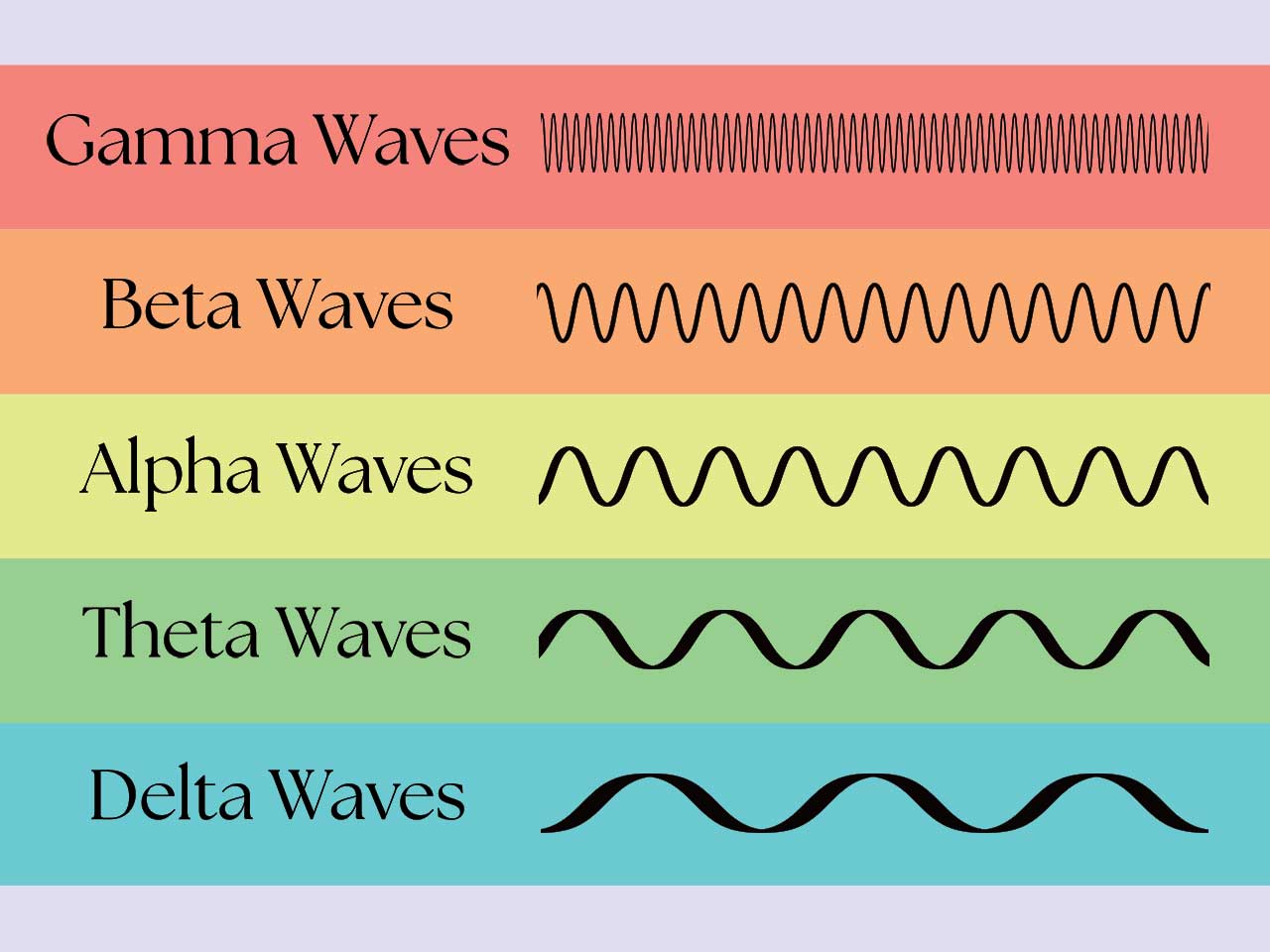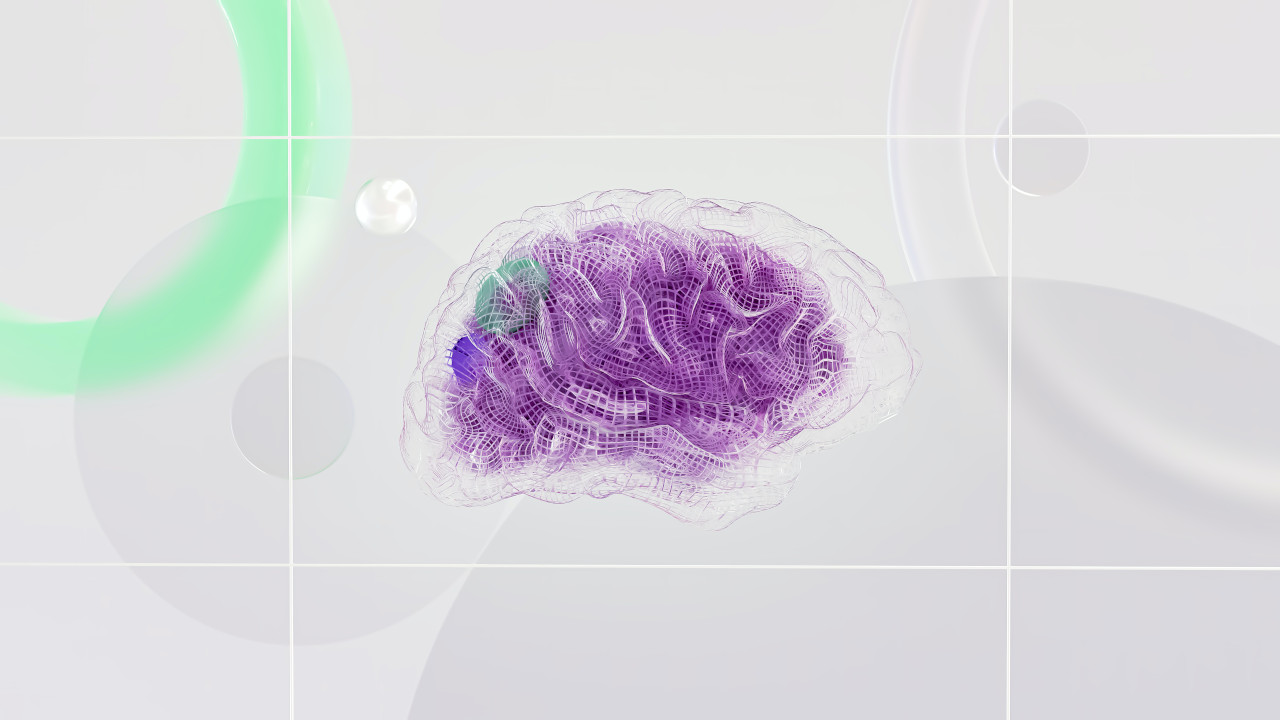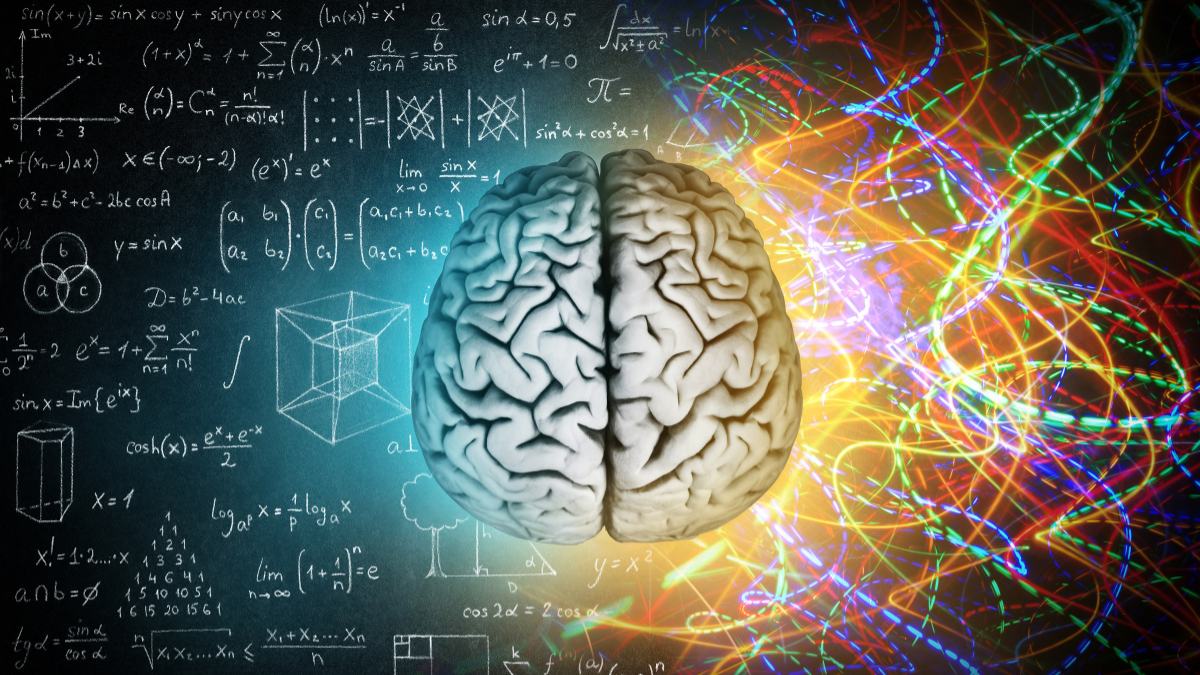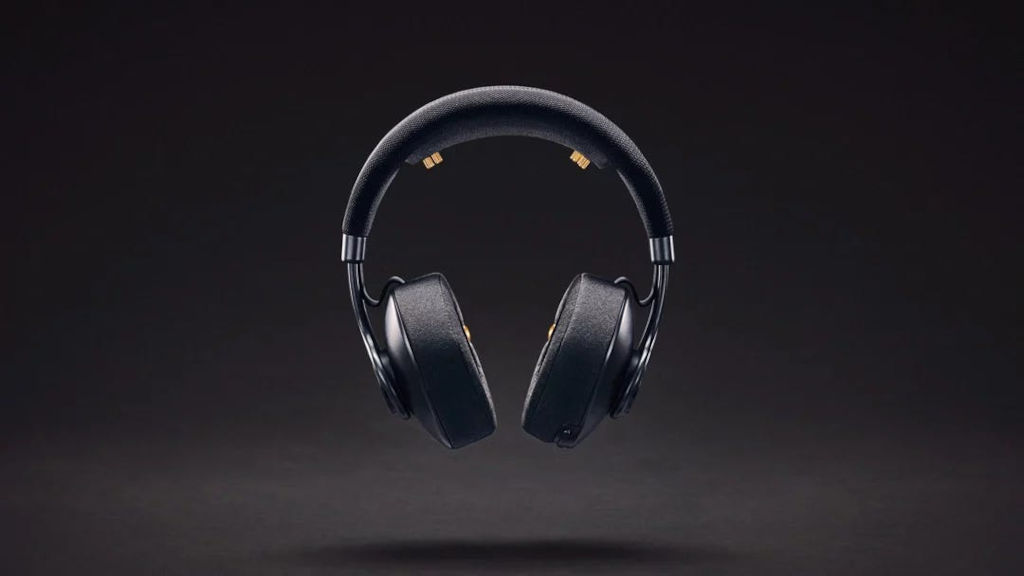The state of your mind at any given moment is characterized by a unique pattern of brainwaves bouncing from some locations to other destinations within your brain—a neural signature of your thoughts.
Neurons are wired in large and wide-ranging networks, and as they communicate these networks produce underlying rhythmic activity, oscillations spanning several scales from slow delta waves of 0.5 Hz up to gamma waves of 100 Hz.
The bands relate to your mental state in an intuitive way—the lower the activity the more relaxed and calm you are, the higher the activity the more alert and active you are.
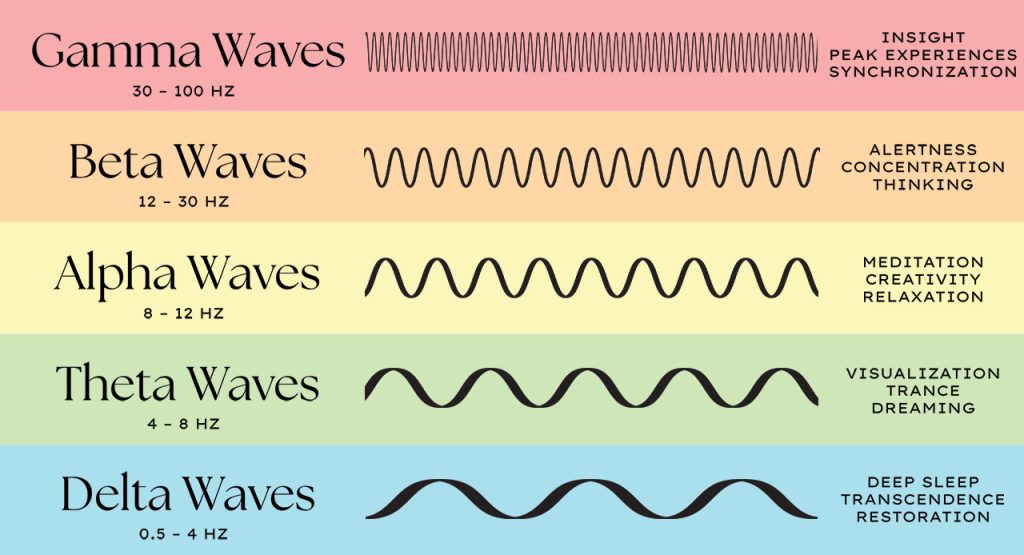
This activity can be picked up using devices like an EEG. By watching your brainwaves on a screen you can get a feel for what’s going on under the hood when you’re in different states—this is called neurofeedback.
But what these large-scale rhythms also allow is for other stimuli to come in and influence them. When other oscillatory stimuli enter the brain via your eyes, ears, or other senses, they can in a sense hack consciousness.
Synchronizing Brain Waves
In the 17th century, the Dutch mathematician, engineer, physicist, and inventor Christiaan Huygens discovered that two periodic systems such as clocks would synchronize together (he had already invented the pendulum clock).
Consider playing a note with a tuning fork—if it’s played at a natural frequency of another object like a guitar or a glass, that object will start vibrating at that frequency. If you play that note with enough force you can shatter the glass.
In the 1920s the German psychiatrist Hans Berger developed electroencephalography (EEG), which can measure brain activity, and discovered that the brain also oscillates. The alpha rhythm he first measured has been called the Berger wave.
This raised a question—would the brain synchronize to periodic stimuli like other objects do?
While the brain is vastly more complex and dynamic than glasses, guitar strings, and pendulums, the answer still turned out to be yes. Through a process called brainwave entrainment.
Not long after Berger developed the EEG, the pioneering physiologist and Noble Prize winner Edgar Adrian explored the effects of flickering lights on Berger’s alpha brain wave, noting that it strengthened the existing oscillations:
“[A] coordinated beat is imposed on the area by the rhythmic excitation, whereas with the spontaneous waves there is nothing but their own interaction to synchronize the different neurones.”
Things have progressed rather wildly since then. William Grey Walter, a neurophysiologist that identified other brain waves such as Delta, experimented with stroboscopic lights and found they could produce visual hallucinations.
This inspired artist Brion Gysin and technician Ian Sommerville to create the Dreamachine in the 1960s, an art device that uses pulsating lights to induce different visual sensations and states of mind (a modern version of this recently made its way through the UK).
With the continued development of neurofeedback technologies and a better understanding of the brain, interest in brainwave entrainment and consciousness hacking more generally has expanded significantly.
Today, a variety of methods of brainwave entrainment are used in various settings to achieve different results—including deeper meditation and relaxation, cognitive enhancement, pain reduction, and alleviation of conditions such as anxiety and depression.
What the Science Says
Brainwave entrainment involves introducing a stimulus with a frequency that matches the desired brain waves, with the goal of synchronising the two. For example, if you want to relax, you might play audio with a frequency of 8 Hz to enter a low alpha state.
With our current understanding of brainwave entrainment coupled with affordable neurofeedback devices, it’s easier than ever to take advantage.
Here are some of the avenues you can take towards brainwave entrainment:
1. Binaural Beats
Heinrich Wilhelm Dove discovered binaural beats in 1839 when he used tubes to route the sounds of two slightly different tuning forks to each ear, with the listener curiously observing the appearance of a third tone.
Playing two different frequencies into opposite ears creates the perception of a beating pattern whose frequency is the difference between those two present tones. For example, if you play a 400 Hz signal into one ear and a 410 Hz signal into the other, you’ll hear a 10 Hz beat.
This third tone isn’t present in the signals themselves but is generated in the superior olivary nucleus, a structure deep in the brainstem, making it something of an illusion.
It took until the 1970s for researchers such as Gerald Oster to start investigating the properties and effects of binaural beats, and how they can produce brainwave entrainment.
Studies have since found binaural beats can help reduce anxiety and improve quality of life, as well as provide pain relief. They’re now the most well-known and popular of the brainwave entrainment methods, you’ll find ample examples on Youtube or Spotify.
2. Monaural Beats
Very similar to binaural beats, monaural beats are a type of auditory brainwave entrainment that involves presenting a single tone that has been modified to create the beating pattern.
So, instead of the pulsing tone being created in your head as with binaural beats, it’s being achieved at the source. This means you only need one speaker instead of a pair of headphones.
The combining of the tones to create the beating effect is often achieved digitally, but not always—it is something string instrument players are very familiar with.
When you tune a guitar, for example, it’s common to use a note on one string to get another in tune with it, but when they’re still slightly out of sync you get a pulsing sound that’s the remaining difference between them.
Given the similarities between binaural and monaural beats, we should see similar effects, and while monaural beats haven’t seen as much research the results so far support it, with some studies finding reduced anxiety and promoted relaxation.
3. Isochronic Tones
Isochronic tones, along with binaural and monaural beats, make up a category of brainwave entrainment called ‘auditory beat stimulation’.
What sets isochronic tones apart from the other two is that it’s a single audio signal of a series of tones presented at regular intervals, which creates the pulsing sound.
No signals are mixed at any point, it’s a single tone repeating at the desired brainwave frequency. No headphones required, just a single speaker with clear and audible sound.
There is much less research on isochronic tones than there is on binaural beats, but given their similarities we should expect they too have a positive effect. Plus, given the ease of access, it’s worth trying out and seeing for yourself.
4. Photic Stimulation
Here we turn to light. Photic stimulation goes back to Edgar Adrian’s explorations of alpha waves in 1934, and involves a strobe light flickering at the desired brain wave frequency. The resulting entrainment is known as the ‘photic driving response’.
Photic stimulation is used to diagnose conditions like epilepsy, which is an abnormal pattern of brain activity that can start in response to flickering light patterns. Naturally, if you are epileptic this is not something to be done at home or without professional support.
I’m sure some consciousness-hacking enthusiasts will be interested to learn that early researchers like William Grey Walter and artist Brion Gysin found that patterns of light could produce hallucinatory experiences and altered states of consciousness.
This is a more difficult set-up than the auditory options above, as you’ll need to find strobe lights or flickering LEDs, and tune them to the desired frequency, and the resulting effects will be of a quite different variety.
5. Audio-Visual Entrainment
If it’s not obvious from the title, audio-visual entrainment is a form of brainwave entrainment that combines both auditory and visual stimuli to produce changes in brainwave activity.
By combining auditory and visual signals it’s thought you can enhance the brain’s entrainment and produce deeper, more immersive states of relaxation and concentration.
However, for this to work you need a device or devices capable of synchronizing flashing lights and pulsing sounds at specific frequencies that correspond to desired brainwave states.
If you can manage that, some research has suggested everything from greater relaxation to improved cognition and reduction in symptoms of pain and depression can result.
6. Haptic Stimuli
Haptics relate to touch and tactile stimuli, so you might also see it called tactile stimulation. It relates to using vibrations of different frequencies that are picked up through the skin to influence brain rhythms.
The vibrations can be achieved with physical touch, such as using a massage gun, but can also occur through low-frequency audio tones—just think of how you can feel the bass from certain speakers.
Some research has found haptic stimulation can improve short-term memory, and vibroacoustic therapy is growing in popularity, but more research is needed to truly understand how effective haptic-based brainwave entrainment can be.
Interestingly, haptics can be used in a different form of consciousness hacking than just brainwave entrainment. It is a popular medium through which people can learn to ‘see’ or ‘hear’ again.
In the 1980s, researcher Paul Bach-y-Rita coined ‘sensory substitution,’ the idea that you can turn one sense into another. He then developed a device that vibrates the tongue in response to visual input and was used by the blind mountain climber Erik Weihenmayer.
More recently, Neuroscientist David Eaglement built the Neosensory, a wristband that vibrates in response to sounds, allowing the deaf to hear through touch. The brain is great at deciphering patterns, feed it the data and it’ll make sense of it in time.
7. Transcranial Magnetic Stimulation (TMS)
The brain relies heavily on electrical signals to communicate, and we’ve known for some time that electric and magnetic fields go hand in hand. As such, you can change the electric patterns in the brain by applying a magnetic force.
In this case, a magnetic coil with an electric pulse is placed over the head to create a current and stimulate nerve cells within the brain. It’s been shown that TMS can entrain alpha brain waves.
It’s most often used to treat mental illnesses from depression and addiction to dementia and stroke rehabilitation. However, it’s also shown promise in enhancing cognitive functions and boosting memory.
While TMS is technically a noninvasive method of altering brain rhythms, it is quite a bit more forceful than the other options in this list, and something best done with an experienced professional at hand.
8. Neurofeedback Meditation
This is a quite different form of brainwave entrainment, as the external stimulus is the digital readout of the brain waves themselves.
As you meditate, you wear an EEG headset that records your brainwave activity, and as you watch your brain waves on the screen you’ll notice how they change with your meditative state.
As you’re getting constant feedback, it’s easier to train your mind to adjust your brain waves more accurately. In essence, it’s a feedback loop where your current brain waves influence your future brain waves that makes neurofeedback training so powerful.
Because this relies less on the frequency of an external device and more on your internal state, with a little practice and patience you should be able to achieve whichever range of brain waves you most desire.
But for the same reason, it can be a more challenging route given you don’t have a reinforcing sound or visual to give you a push. If you can muster the willpower, however, you’ll get all the benefits of meditation along with better control over your mind.
Harnessing the Power of Brainwave Entrainment
Brainwave entrainment is an evolving and exciting area of research that’s gained the attention of many enthusiasts and professionals alike.
Whether it’s to alleviate conditions like anxiety or depression, to enhance cognitive performance or achieve deeper states of relaxation, or perhaps you’re simply curious, there are a variety of techniques available to explore.
Each has its unique benefits and limitations, with the auditory techniques—binaural and monaural beats, and isochronic tones—being the most accessible, while transcranial magnetic stimulation sits at the other end of the spectrum.
But they all can offer a route to hacking consciousness, and as our understanding of brain waves grows and the technologies capable of altering them continue to develop, they will only become more effective.

